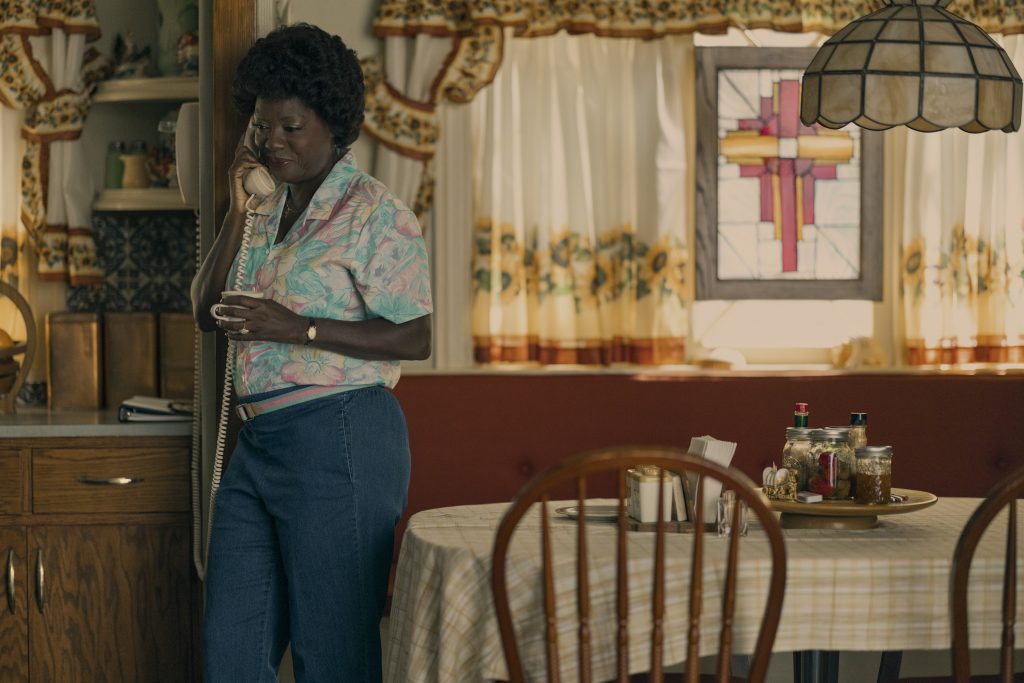
The year was 1984, and Nike, the footwear company, was experiencing an extreme lull in their basketball shoe division. The film Air, directed by Ben Affleck, dramatizes the courtship of a young rookie draft pick, Michael Jordan, to become their new spokesperson and model for what would become their winning high-top Air Jordans. Fiercely protected by his parents, specifically his mother Deloris (Viola Davis), basketball talent scout Sonny Vaccaro (Matt Damon) made the trip from the Nike offices in Beaverton, Oregon, to Jordan’s Wilmington, North Carolina, home, where he wooed her to convince her son to choose signing with Nike over Adidas and Converse.
Locations for the sets, such as the Nike headquarters doppelganger, were in Santa Monica, California, built in a business park, with the interior of the office décor culled together through extensive research by production designer François Audouy (The Wolverine, Logan, Ford v. Ferrari). audouy closely collaborated with Affleck’s alum set decorator Jan Pascale to find just the right desks and clunky computers to fill the enormous office space setting.
Building the worlds of Michael Jordan and Nike were surprisingly not historical recreations, but as close as they could get from photos and videos referencing the 1980s. The sets for each character were carefully created by backstories that audouy found in readings, such as Jordan’s childhood home, which featured religious knicknacks and furnishings to tell the story of Deloris Jordan, and video footage of Nike CEO Phil Knight (Affleck) to inspire his office and humble beginnings.
Below The Line spoke with Francois Audouy via Zoom video from his office in Raleigh Studios in Los Angeles, where he talked about designing the 1980’s corporate culture of Air, revealing their source for vintage Nike shoes. audouy described working with Ben Affleck who he says “created an atmosphere like summer camp.”
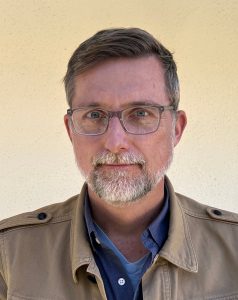
Below The Line: What struck me about this film is that you have the real places that you could model after. How beneficial was that?
Francois Audouy: We had real places, but I think the movie makes it feel like it was a recreation of actual historical references. But the fact of the matter is that we did copious amounts of research and found very little historical reference. For instance, in 1984, Nike headquarters were not very well documented. I mean, there’s no reason why they should take a photo of a boring office in Beaverton. But we did find photos that were like artifacts. They were as rare as hen’s teeth.
We actually found a very rare video of the Jordan family coming to Nike for the first time, which was recreated in the movie. But that’s kind of about it. We had to fill in the blanks, and we did that by looking at photos of corporate culture in the mid-eighties and other similar American companies that were of similar scale. It gave us the liberty to have fun with some of the vernacular styling of these offices. The corporate language look was a fun one to be inspired by.
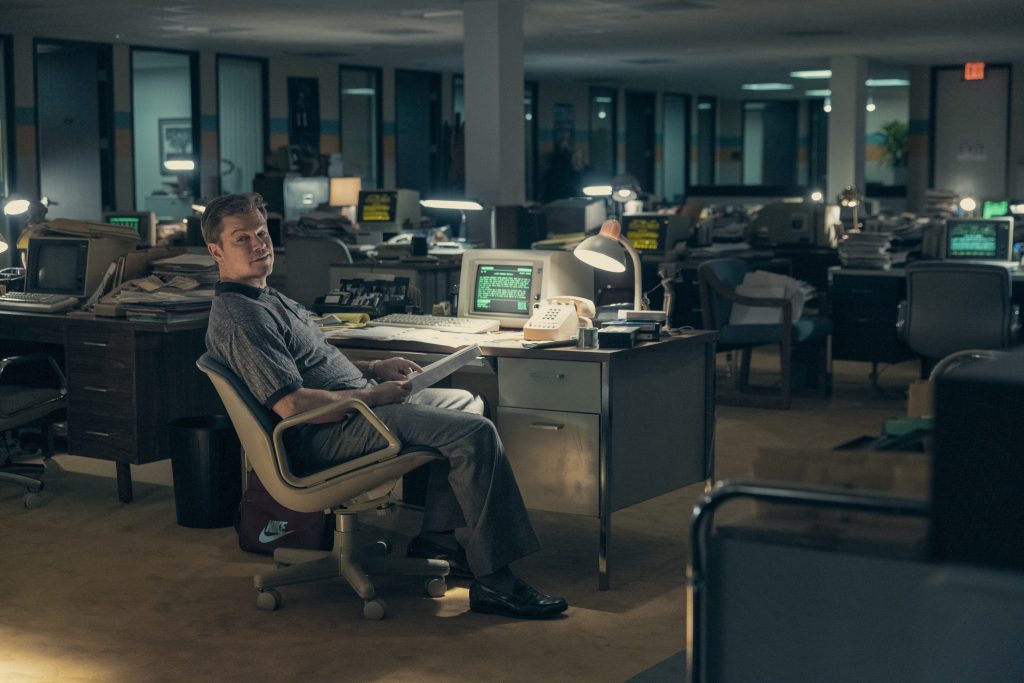
BTL: What was the actual location for Nike headquarters?
Audouy: The headquarters of Nike were built into two stories of a building in the Santa Monica business park that we found, and we moved into this empty office. We were very fortunate to have a lot of options for office space because there was so much empty office space because of COVID. We found this great building that we just took over, and it was our main set, but it was also the entire production.
It was like a little walled city with the entire production there: editorial, production, art department, costumes, set deck, props. Everybody was under one roof, and every day we could all cross-pollinate, be inspired, and see all of our work happening in parallel.
BTL: It’s interesting because I grew up in the ’80s and I don’t consider that decade vintage, but is actually is.
Audouy: I also grew up in the 1980s, and I remember the 1980s, but what’s hard for me to believe is that now I’ve reached middle age, and I’m basically the same as the people I used to work for who had memories of the 1950s. So the ’80s are our ’50s, if that makes any sense. It was a while ago, it turns out, and it’s harder to find these items—you know, the dressing, the details, the computers, and all of that ephemera that existed.
BTL: So how did you find it?
Audouy: We had one of the greatest set decorators in the business, Jan Pascale, my partner on this, who had worked with Ben before on Argo and was is just so phenomenal and such a force of nature. She’s one of the eminent set decorators in Hollywood, but even for her, it was a big challenge because we had 22, 000 square feet of contiguous office space that had to be dressed.
Ben kept opening doors in this office in these buildings, and then we would see into all these back offices and they needed something in them. So she ended up having to widen her search to beyond the prop houses of Hollywood into other suppliers in Texas and all over the country to find the authentic looking dressing to populate all this space, not only the Nike offices, but Converse, Adidas, and all these other sets that make up the story.
BTL: What about the actual locations? Did you shoot in Oregon where the Nike offices were based and Wilmington, North Carolina where Michael Jordan grew up?
Audouy: All the first unit stuff was shot in LA, mostly on location. There were two sets that were done on stage: the Converse boardroom and the Adidas boardroom. Everything else was done in location, kind of the old-fashioned way—the way that they used to make movies in Hollywood. When I started out, you would be based in L.A., and you would go for two or three weeks on location to get the period look, and then come back.
Ben very smartly did a hybrid effect where we actually shot in Beaverton and Oregon with a 2nd unit and also in Georgia, which doubled to the Wilmington area. It was so well done that when you cut it together, you really feel like it’s a movie that’s gone on the road. We meticulously copied the locations and tried to bring in details from the locations in Oregon and Georgia into our locations in Los Angeles. There’s a lot of clever Hollywood trickery to make that illusion feel real.
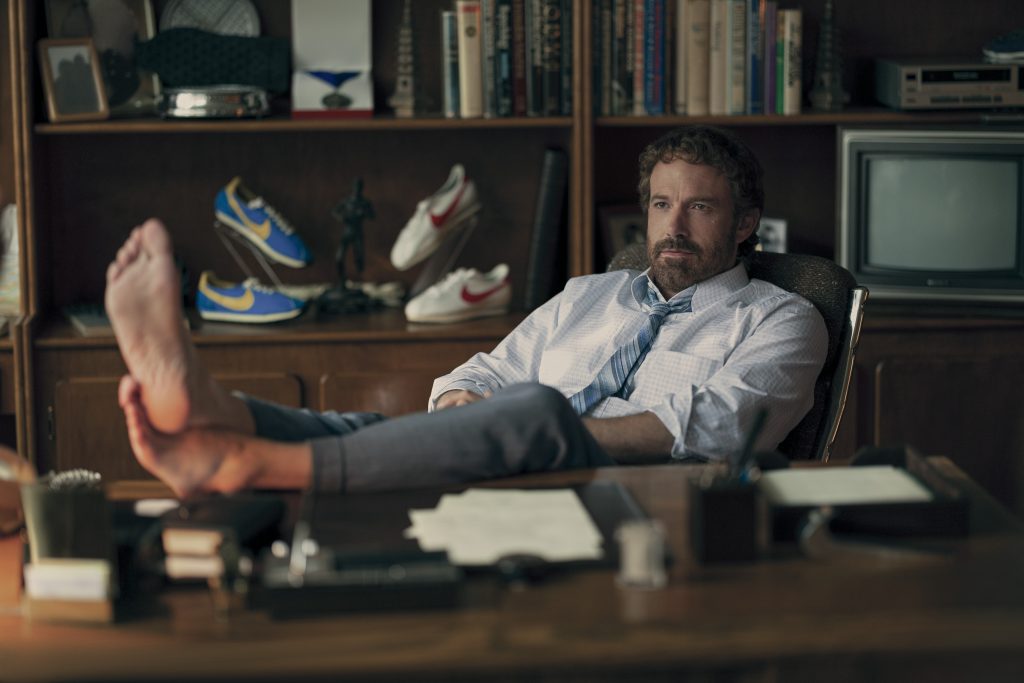
BTL: How about nailing the authenticity of Phil Knight’s office?
Audouy: We found a CBS interview with Phil Knight from the mid-’80s walking through his office. We found a couple of photos of his office. We found some photos of the building. We found real estate documents about the building, the square footage, and how it was laid out. One of the spaces where we had some reference imagery was the desk area, which could help speak to his character. I also read his biography, and we did a lot of character research and learned about his trips to Japan at a very young age that inspired him to start Nike.
It was started as a company called Blue Ribbon Sports, and we put in oriental furniture and Japanese hues that spoke to his character and to his passions. His room is kind of filled with history, and there’s a big built-in shelf behind his desk that shows his entire journey, 1984 childhood photos, meticulously selected books that would speak to his specific philosophies as a CEO, books like “The Art of War,” business books, and some other stuff that we found in the photos and things like that.
Blue Ribbon Sports was started out of the back of a Volkswagen van, so we staged a photo of the Volkswagen van, recreated that photo, and had the first dollar bill that he made. We found a lot of specific pieces that spoke to his history, including his original shoes, which were artifacts from the time that we were able to get from a company at a museum called ShoeZeum that has the largest collection of vintage Nikes, and we made a deal with them. The owner of the shoes came with them. He wouldn’t even send them on the plane. He actually came and delivered them door-to-door because they were so rare and valuable.
BTL: In the conference room with Rob Strasser, that recruiting board looks really authentic. What inspired that?
Audouy: Part of my job as a production designer, especially for a movie like this, is not to make anything so distracting as to take away from what’s going on. I really like the fact that it takes a lot of work to make it feel like you didn’t do anything, and the fact is that every single square foot of flooring, walls, ceiling, and everything else was created from bare nothing. It was just a bare concrete floor and drywall space.
Specifically in the conference room, there’s a couple of things we wanted. It had to be authentic to the kinds of rooms where the actual work is done at these companies. It has to have a tone and a feeling of a company that is out of their breath a little bit in basketball. It had to feel grounded, and you had to kind of feel for these underdogs working in the basketball division. That was really the feeling that Jan and I were after for the basketball division in the conference room and all that kind of sad sack of a space.
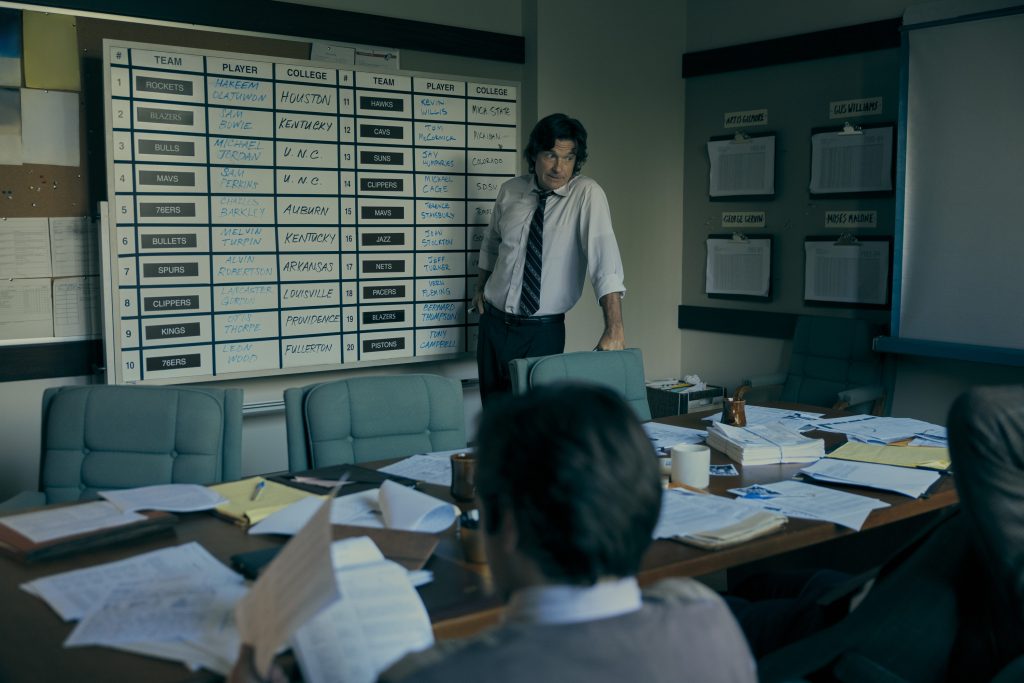
BTL: That is very cool. What about Michael Jordan’s mother’s kitchen? The knickknacks alone seem very specific.
Audouy: All these sets really come from lots of research, and Jan and I love talking about character backstory and about who these characters were at the time. We did a lot of research on the Jordan family and learned that, at the time, she was working at a bank as a teller. She’s an incredibly strong character who raised these great kids.
We wanted to evoke and tell the story of how formidable she was through her surroundings. She’s also from a religious family, so there were some religious cues, like the stained glass, which Jan found at a Long Beach swap meet and just grabbed and didn’t know how to use. But that stained glass piece then becomes like an anchor to fill in the other details in the space.
BTL: I know that Ben Affleck met with Michael Jordan. Did what he learned inform you?
Audouy: Ben met with Michael Jordan for about five hours the day before we all started. So, he had come off the plane after spending a whole day with Michael Jordan at his golf course in Florida and was just overflowing with information, inspiration, ideas, and feedback. There were changes to the script, and the development came from that initial meeting between Ben and Michael.
Ben did a lot of his own research and viewed a lot of the people himself who worked at Nike, and he just infused the script and the sets with so much detail beyond just directing the scenes. He was just very inspiring, and you feed off of his enthusiasm and just try to keep up.
BTL: Do you feel guilty like you’re cheating on James Mangold working with Ben? What makes him such a good director?
Audouy: (laughs) Absolutely not. James had enough stuff going on, and we’re going to be working again together on his next film, A Complete Unknown, the Bob Dylan biopic. It’s okay to go see other people sometimes. With Ben, it felt like everybody was at a summer camp. It took place over the summer in Santa Monica. Ben is so enthusiastic and energetic and available and communicative with everybody across the board that he really inspires you to do your best work. Plus, he assembles department heads who are at the top of their craft. This is actually something really special—to be invited into a group of filmmakers that are of the highest caliber.
Also, Ben is so funny, and he’s so smart. We would go location scouting, and he would pull out his phone and play his Spotify playlist of the songs from the movie. He would know the words and jump in and then be like, “This plays when we walk into the shoe lab in the basement of Nike.” He’s so excited, and you just can’t help but be swept away by the way that he describes the scenes and visualizes the movie. He’s just a delightful person to have as a boss. He’s got a childlike enthusiasm for the material that sweeps us all up into being excited about realizing his vision.
BTL: When you watch the film, what are you most proud of?
Audouy: I’m most proud of the fact that when (Nike marketing executive) Sonny Vaccaro came to the space and walked around, he was tearing up because he could feel that his friends had been authentically represented in their spaces—many friends who aren’t with us anymore.
Jan and I put a lot of details into these offices that speak specifically to the backstories of these characters that we only learned about from doing lots and lots of research. Sonny saw those things, and they reminded me of his friends, and that really made it all worth it.
Air is now available to stream on Prime.





